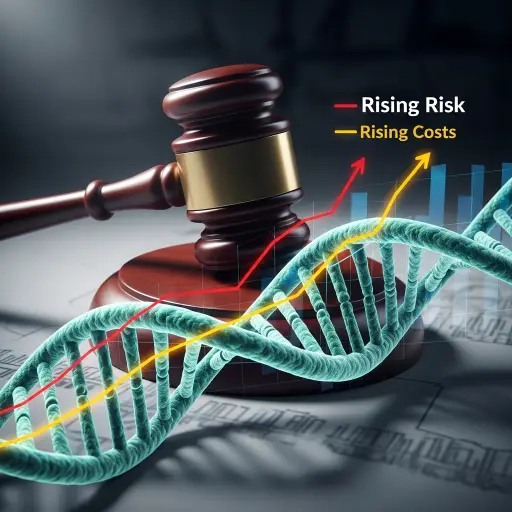Data Stewardship: How 23andMe’s $9 Million Breach Fallout Reshapes Genetic Privacy
In a world where your genome can travel farther and faster than your grocery list, a $9 million settlement reverberates beyond a courtroom. It is a narrative about how data, once blessed as the new oil, becomes a liability when governance lags behind ambition. 23andMe’s recent settlement—originating from a data breach that exposed customer information—offers a case study in the economics of privacy, the friction between consumer genomics and risk management, and the practical steps investors, executives, and ordinary readers can take to stay one step ahead of the liabilities that live inside DNA.
The macro thread is straightforward: the private sector monetizes biology; the public, regulators, and stakeholders demand accountability. The breach itself didn’t merely expose emails, addresses, and genotype data; it challenged the business model that treats genetic data as an enduring, tradeable asset. The settlement signals a price tag for governance gaps—how much it costs when a consumer platform fails to safeguard a unique, immutable data type. It asks: who pays for risk, and how is that cost distributed across product design, investor expectations, and user trust?
23andMe’s defense, like many modern technology stories, rests on scale and reassurance. The company argued its consumer strategy—massive data aggregation for ancestry services, health insights, and research partnerships—remains strong. The counterpoint from privacy advocates and some investors is that scale magnifies potential harm; the larger the dataset, the bigger the incentive for misuse or misconfiguration. The settlement, therefore, is less about punitive numbers and more about governance reform—contracted diligence, enhanced security protocols, and transparent user communication. In short, risk management becomes a product feature, not a back-office afterthought.
From a purely economic lens, the $9 million is small relative to 2024–2025 venture-finance burn rates and the market capitalizations of consumer genomics players. Yet the optics matter. The payout is a wake-up call to investors: data privacy is not a one-off compliance box to tick; it is a recurring line item in valuation models, insurance premiums, and executive incentives. If a breach can trigger a nine-figure settlement in a different sector, health-tech and genomics firms must reprice cyber risk into their cost of capital. The market’s spread tightens around governance, and the premium for “privacy by design” climbs accordingly.
Guidance for readers and stakeholders follows a simple, increasingly urgent logic: privacy is not a shield but a system. It is built from people, processes, and tech, and it must be reinforced continually. For individuals, there are practical steps—limit distribution of highly sensitive identifiers, enable multi-factor authentication, and stay vigilant for phishing that tries to piggyback on genome-linked services. For families worried about inherited risk data, consideration of consent scopes, data-sharing controls, and future use-cases becomes part of daily risk budgeting, not a once-a-year compliance exercise. For investors, the message is to demand explicit governance metrics in board dashboards: data minimization, third-party risk oversight, incident response drills, and transparent breach disclosures that quantify residual risk.
The article’s core proposition, seasoned through the 23andMe episode, is this: genetic data is an asset class with an evolving risk profile. Its value is meaningful when accompanied by robust governance, not merely brilliant segmentation models or glossy health dashboards. The settlement’s implication stretches beyond the number on the press release. It recalibrates expectations for product design, insurance purchasing, and corporate reporting. It reframes privacy from a mere feature to a strategic constraint—one that shapes who can access data, for what purpose, and under what safeguards.
To connect the threads to a practical blueprint, consider three anchors:
Governance first, economics second. Build data-use policies that are explicit about consent, retention, and re-use. The numbers will follow as investors reward transparency and risk discipline.
Security as product capability. Treat security engineering as a feature with measurable outcomes: mean time to detect, time to contain, and time to recover. Publish these metrics in investor decks and public disclosures.
Consumer literacy as risk buffer. When users understand how their data travels, they are more deliberate in their participation. Plain-language summaries, opt-in controls, and accessible breach-notice language reduce the cognitive load of risk.
The crescendo of this story lands at the intersection of ethics, economics, and engineering. The $9 million is not merely compensation; it is a proof point that the future of consumer genomics sits on a governance ledger as much as on a genome ledger. The next wave of products—ancestry timelines, precision health prompts, population-scale research—depends on how well firms design and disclose risk. Investors will reward those who can narrate a coherent risk framework and demonstrate iterative improvements in protection and transparency.
In the end, the article argues for a cadence of thinking: read the settlement not as a verdict but as a blueprint. The numbers, while critical, are breadcrumbs pointing toward a broader architecture of trust. For readers—as citizens, as consumers, as potential investors—the lesson is compact: preserve autonomy by insisting on robust, repeatable safeguards; demand governance that evolves; and treat genetic data not as a one-off asset but as a living part of a responsible, investable enterprise.
If memory serves, the most durable investments are those that can prove they manage uncertainty better than their peers. The 23andMe case is a reminder that the surface value of data is inseparable from the deeper discipline of stewardship. The genome is personal; governance matters no less.
Sources
Regulatory filings, 23andMe settlement press releases, data breach notices, privacy research on genomic data ethics, and investor analyses.
